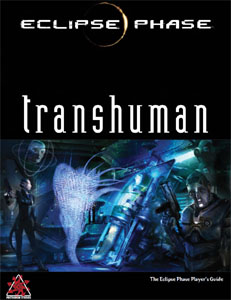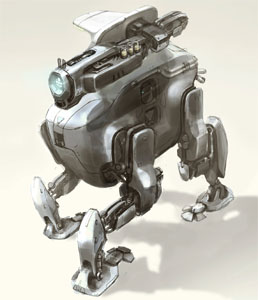 This post is a little hyper-specialized in its focus, but it was a mechanical concept that was tickling my hindbrain so I decided to just pull the trigger on it.
This post is a little hyper-specialized in its focus, but it was a mechanical concept that was tickling my hindbrain so I decided to just pull the trigger on it.
Flexbot morphs are formed from multiple, shape-adjusting modules which can flexibly reconfigure themselves into a multitude of forms: Multi-legged walkers, tentacles, hovercrafts, and so forth. In addition, their individual modules are capable of sprouting fractal-branching digits (capable of breaking into smaller digits down to micrometer scales, allowing for ultra-fine manipulation).
Eclipse Phase: Transhuman introduces a new set of rules for flexbots allowing them to incorporate specialized modules. (For example, a Beekeeper module can be used to deploy nanoswarms.) In order to support these specialized modules, Transhuman also introduces a system for calculating the characteristics of a morph formed using various configurations of specialized modules.
In order to use these rules, however, you need the stats for a basic flexbot module. Transhuman provides stats for a Yeoman module which is supposed to replace the basic flexbot morph, but it actually results in a very different stat block. So what I’ve done is to create a basic flexbot module that you can use to build a flexbot morph virtually identical to the one described in the core rulebook. I’ve also tossed in a cheap flexbot module and also something nifty called a silvershot module.
NEW FLEXBOT MODULES
A basic flexbot morph (as described in Eclipse Phase, pg. 144) contains 5 basic flexbot modules.
(Following the rules for combining flexbots, this would actually result in a morph with Durability 24 instead of the Durability 25 found in the core rulebook. But that’s the closest you can mathematically get.)
BASIC FLEXBOT MODULE
 This is the basic module found in a typical flexbot morph. In a typical configuration, one of those modules is the size of a small dog (roughly 75 centimeters high x 75 centimeters long x 25 centimeters long), but they’re capable of significantly compressing or extending their dimensions using their Shape Adjusting enhancement (see Transhuman, pg. 208).
This is the basic module found in a typical flexbot morph. In a typical configuration, one of those modules is the size of a small dog (roughly 75 centimeters high x 75 centimeters long x 25 centimeters long), but they’re capable of significantly compressing or extending their dimensions using their Shape Adjusting enhancement (see Transhuman, pg. 208).
Enhancements: Access Jacks, Basic Mesh Inserts, Cortical Stack, Cyberbrain, Fractal Digits, Mnemonic Augmentation, Modular Design, Nanoscopic Vision, Shape Adjusting
Mobility System: Walker (4/16), Hover (8/40)
Aptitude Maximum: 30
Durability: 8
Wound Threshold: 2
Advantages: Armor (4/4)
Notes: Small Size trait (Transhuman, pg. 95)
CP Cost: 4
Credit Cost: High
CHEAP FLEXBOT MODULE
Originally marketed by Starware, this cheap alternative to a typical flexbot module quickly gained an extremely negative reputation. Consumer advocacy groups leaked the full blueprints for the design in an effort to discredit Starware, but this ironically just resulted in a lot of people having access to it. Down-on-their-luck flexbots sometimes don’t have any choice but to substitute in a cheap Starware knock-off if one of their main modules is damaged.
Enhancements: Access Jacks, Basic Mesh Inserts, Cortical Stack, Cyberbrain, Mnemonic Augmentation, Modular Design, Shape Adjusting
Mobility System: Walker (4/16), Hover (4/28)
Aptitude Maximum: 20
Durability: 6
Wound Threshold: 2
Advantages: Armor (2/2)
Disadvantages: Lemon trait
Notes: Small Size trait (Transhuman, pg. 95)
CP Cost: 1
Credit Cost: Moderate
SILVERSHOT MODULE
 Silvershot modules are designed with specialized, multi-channel connections using superconducting material to synchronize high-speed, cross-modular communication through massive redundancy. A flexbot formed entirely from silvershot modules can move like quicksilver, although the advantage debilitates rapidly if non-silvershot modules are introduced.
Silvershot modules are designed with specialized, multi-channel connections using superconducting material to synchronize high-speed, cross-modular communication through massive redundancy. A flexbot formed entirely from silvershot modules can move like quicksilver, although the advantage debilitates rapidly if non-silvershot modules are introduced.
Enhancements: Access Jacks, Basic Mesh Inserts, Cortical Stack, Cyberbrain, Mnemonic Augmentation, Modular Design, Shape Adjusting
Mobility System: Walker (4/16), Vectored Thrust (8/40)
Aptitude Maximum: 30
Speed Modifier: +1 (Reflex Boosters)
Durability: 8
Wound Threshold: 2
Advantages: REF +10, Armor (4/4), Reflex Boosters
Notes: Small Size trait (Transhuman, pg. 95)
CP Cost: 8
Credit Cost: High (minimum 10,000)
COMBINING FLEXBOT MODULES
Unless noted otherwise, only physically attached modules should be considered when combining the modules of a flexbot into a flexbot morph’s stats.
Enhancements: In general, the flexbot morph is considered to have all of the enhancements and traits available to their individual modules. The exception would be any enhancement or trait that would require the entire morph to be augmented (unless, of course, all of the flexbot’s modules possess the enhancement or trait). (For example, a chameleon skin would only cloak the module possessing it.)
Mobility System: For each module which lacks a specific mobility system, the movement rate of the morph with that mobility is halved. (This penalty is cumulative for each module which lacks the mobility system.)
 Flexbot modules can reshape themselves to possess any mobility system based on purely mechanical principles (hopper, hover, roller, rotorcraft, snake, submarine, tracked, walker, wheeled, winged). A module cannot have more than two mobility systems shaped at a time. Assume shaped mobility systems have a movement rate of 4 meters.
Flexbot modules can reshape themselves to possess any mobility system based on purely mechanical principles (hopper, hover, roller, rotorcraft, snake, submarine, tracked, walker, wheeled, winged). A module cannot have more than two mobility systems shaped at a time. Assume shaped mobility systems have a movement rate of 4 meters.
Aptitude Maximum: Use the highest maximum available for each aptitude.
Speed Modifier: Flexbots use the Speed of its slowest module.
Durability: Take the highest Durability among the flexbot’s modules and add half the Durability (round up) of each additional module. Calculate the morph’s Wound Threshold (Durability ÷ 5) and Death Rating (Durability x 2) normally based on the morph’s total Durability.
- Damage: Damage is assumed to be evenly divided between a flexbot’s modules. (As an optional rule, determine which specific module was hit and apply the damage accordingly. This would only become important if a specific module separates from the flexbot or if that module is disabled, in which case the flexbot would lose any enhancements or traits specific to that module.)
Advantages/Disadvantages: As with enhancements, a flexbot morph is considered to have all the advantages and disadvantages possessed by their individual modules.
- Ability Scores: Flexbots use the highest bonus for each aptitude. Multiple bonuses to the same aptitude from different modules do not stack.
- Armor: A flexbot’s Armor Value is equal to the average Armor Value of its modules (round up).
- Individual flexbot modules count as a small target (-10 modifier to hit in combat)
This is a quick reference. Refer to Transhuman (pg. 203-206) for the complete rules.

















